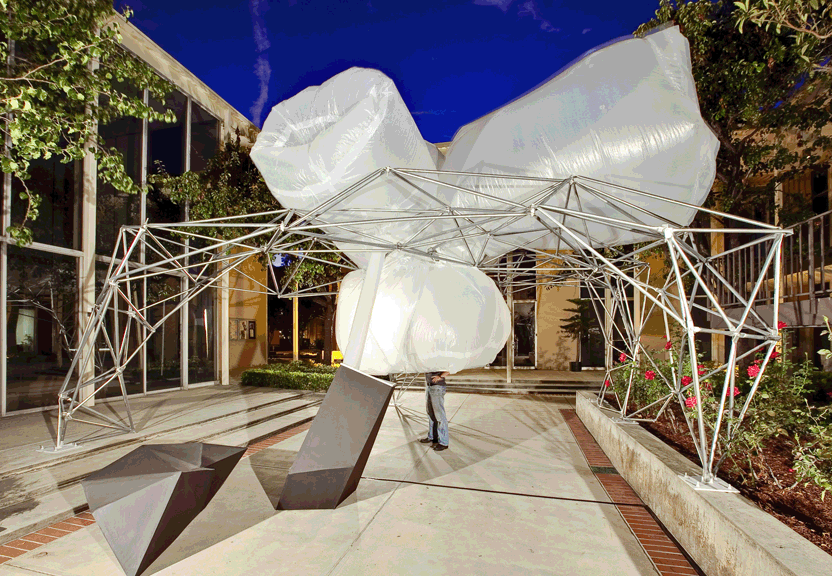|
density frames
USC University Religious Center los angeles, california |
||||
The Density Frames installation is the iterative cousin of Light Frames. Published in the USC newspaper, Reverend Burklo admired Light Frames and asked if it could be reinstalled at the URC. After examining the small budget that would be required to relocate the structures, it became evident that for the same expenditure, the installation could be iterated and customized to the space. Deploying the same two doppelganger parts: a new transparent levitating inflatable and a iterative variably triangulated structure; the relationship evolved from a planametric adjacency to a sectional relationship. Stacked and interpenetrating, the structures negotiate the courtyard of the modernist religious center. Expanding the chapel, engaging the stair and courtyard, and consistently responding to the light and views of their experiential associations the inflatable expands to fill the void. The lower variably triangulated frame is formed through a combination of structural necessity and site based constraint along with spatial goals. As a shallow dome with an ocular void [filled by the penetrating inflatable] the north wall edges the stair and sit son an existing cast in place concrete planter wall. Matching the height of the stair landing, the frame folds in the space to create a lattice ceiling that lands on two figurative legs flanking and framing the chapel. The collective and local shape is form found through structural optimization while providing the density and integrity necessary for the effectual experience. The collective table form serves to catch the deflated drape of the inflatable figure when turned off. The shape emerged from the site. Extending the existing glass chapel to add a second zone of worship the density frames become both a new back and a new front. An apsidal space, traversed by the axis of the existing geometries of the regularized building, the form contrasts through its fractal organicism. The form of the lower variably triangulated structure begins with the Light Frames installation. Using "chunks" of the existing to minimize new fabrication, the interstitial forms are made of feathered together, newly positioned but original pieces. The new form is a full reconfiguration requiring no new fabrication. The levitating inflatable is made of transparent polyethylene plastic. Heat welded joints allow for a clean continuity to the surface and shape. Formed through five arms of transitional tunneling forms, there is an interconnected outer and inner shape. The outer arms align with site constraints referencing historical ecclesiastic forms as well as circumscribing palimpsest religious symbols into one new hybridized collective. The result is a hybridization of all three factors. The inner shape serves as a projective void that bounces light and frames the sky and stars. The choreography of the visual look inward is an individual and spiritual experience of self to object engaging the profound relationship between mind and body through faith. The buoyant shape turns on and off with motion through the space. A series of faceted and internally lit benches scatter below the figures. They house the blowers that feed the upper inflatable while providing moments of repose and contemplation. The collective composition is a dialog between rigid and fixed, and the mutable and floating. This dialogue emerges from the relative relationship of aspiration and inspiration to physicality and humanity as a basis of faith. The installation becomes a canopy, a chapel, a sculpture, etc. but most importantly an instigator. It is a new intervention but also an extension of what has always been there, unnoticed but now temporarily highlighted and framed.
|
llllllllllllllllllllllllllllllllllllllllllllll | |||


